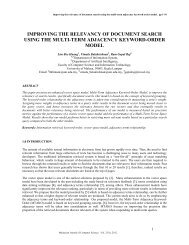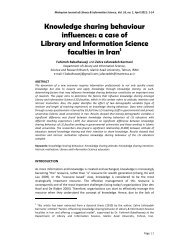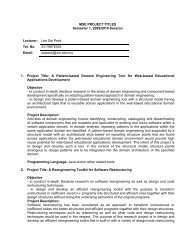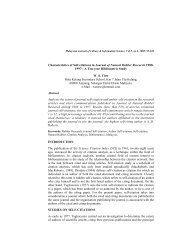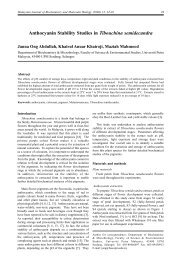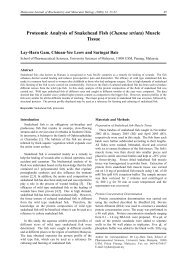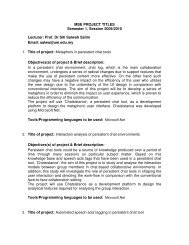Design and Implementation of a Private and Public Key Crypto Processor for Next-Generation IT Security Applications pp. 29 - 45Fig. 13: Architecture of Control Unit and Datapath Module in ECP4.4 SHA Processor for Crypto HashingA hash function maps binary strings of arbitrary length to binary strings of some fixed length, called messagedigest. Hash function with cryptographic properties is called cryptographic hash function. Cryptographic hashfunction is generally a one-way and collision resistant function [14]. It refers to the function that is relatively easy tocompute, but significantly harder to reverse. Collision resistant means that it is computationally infeasible to finddifferent messages with same message digest. The hash function serves to compress the large input data for publickeyencryption/signing function.Among the hashing functions available, the SHA-1 algorithm [15] is preferable. This is because of its balancedsecurity (secure to all known attacks), speed (higher parallelism) and applicability. In SHA-1 algorithm, inputmessage that is less than 2 64 bits is hashed into a 160-bit fixed length message digest. The main operation of SHA-1algorithm is given in Fig. 14.Fig. 14: SHA-1 Message digest computationSHA-1 hash algorithm consists of three main stages, i.e. padding, message digest computation and message digestoutput.• Padding: converts input message into block of 512-bit each.• Message digest computation: Initializes message digest buffers, and then loops the SHA-1 compressionfunction for all converted message blocks, such as message expansion, bit-wise logical function, constantmultiplexing, etc.• Message digest output: Concatenation of five chaining variables after the message digest computation ofthe final compression function loop.38Malaysian Journal of Computer Science, Vol. 19(1), 2006
Design and Implementation of a Private and Public Key Crypto Processor for Next-Generation IT Security Applications pp. 29 - 45Because they are not computationally intensive, the padding stage and message digest output stage are normallyperformed in software. However, the message computation stage is computation demanding, and therefore shouldbe performed in hardware. In this work, the Bosselears’s architecture [16] is modified to exploit parallelism andcustomization offered by hardware. The modification leads to a systolic array implementation of adder tree initeration module.Fig. 15 shows the block diagram of the SHA1_engine module that maps the SHA-1 compression function intohardware. The main unit is iteration-step-variable-update unit that initialize, stores and updates the iteration-stepvariables.The message expansion unit reads and expands external input message word (Mt). The constantmultiplexer supplies a constant word for each iteration step. The logical function unit converts three words (B, C,and D) into single word (Ft) based on logical functions. The feed forward unit stores and updates the chainingvariables, which are finally sent out as the message digests (MD). For an elaborate description of the detail design ofthe proposed SHA-1 hardware core, please refer to [14].Fig. 15: Datapath unit of SHA1_engine4.5 LZSS Processor for Data CompressionIn data communications and data storage system, it is desirable to have faster transfer rates and greater storagecapacity at lower costs. Data compression techniques address these demands by removing redundancy from thesource data and thereby increase the density of transmitted or stored data. Since cryptographic applications requirerestored data to be identical to the original, lossless data compression is applied in this work. The design of thecompression core proposed in this work is based on the combination of Lempel-Ziv-Storer-Szymanski (LZSS)compression algorithm and Huffman coding. In our design of the data compression processor core, the compressionand decompression are performed in separate modules. With a systolic array hardware architecture mappingapproach to part of the algorithm, the resulting IP core offers a data-independent throughput that can process asymbol on every clock cycle. The design is described completely in parameterized VHDL code such that it canprovide a suitable compromise between the constraint of resource, speed and compression saving, and adaptable forany specific target application. For a more elaborate description of the design, please refer to [17].Fig. 16(a) shows the block diagram of the Compression Unit of LZSS processor core. It consists of threehierarchical blocks, which are LZSS coder, fixed Huffman coder and data packer. All the modules aresynchronously clocked. The LZSS coder performs the LZSS encoding to symbols of source data, which is obtainedfrom the Compression Interface, and the fixed Huffman coder re-encodes the LZSS codeword to achieve a bettercompression ratio. Finally, the data packer packets the unary codes from the fixed Huffman coder into a fixedlengthoutput packet and sends it to the Compression Interface. Fig. 16(b) shows the block diagram of theDecompression Unit of LZSS processor core.Fig. 16(a): Block diagram of compression unitMalaysian Journal of Computer Science, Vol. 19(1), 200639



